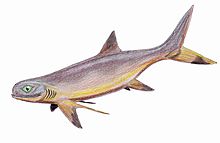Symmoriiformes
| Symmoriid Temporal range:
| |
|---|---|

| |
| Symmorium | |
| Scientific classification | |
| Kingdom: | |
| Phylum: | |
| Class: | |
| Subclass: | |
| Order: | Symmoriida Zangerl, 1981
|
| Families | |
Symmoriida is an extinct order of sharks that contains three families. It was synonymized subjectively with Cladodontida by Lund (1986); it was corrected as Symmoriiformes by Maisey (2008). It was assigned to Cladoselachii by Goto et al. (1988); to Elasmobranchii by Williams (1998); and to Chondrichthyes by Sepkoski in 2002 and by Maisey in 2008. In the fossil record they appear at the beginning of the Carboniferous. Most of them died out at the start of the Permian; however, a single tooth described by Guinot et al. (2013) from the Valanginian of France indicates that members of the family Falcatidae might have survived until the Early Cretaceous.[1]
Fossil distribution

Fossil evidence of Symmoriida have been found at Bear Gulch, Fergus County, Montana,[2] Bethel Quarry, Pike County, Indiana, Kinshozan quarry, Alaska, Gifu Prefecture, Japan, and Bashkortostan, Russian Federation.[3]
References
- ^ Guillaume Guinot, Sylvain Adnet, Lionel Cavin and Henri Cappetta (2013). "Cretaceous stem chondrichthyans survived the end-Permian mass extinction". Nature Communications. 4: Article number: 2669. doi:10.1038/ncomms3669.
{{cite journal}}: CS1 maint: multiple names: authors list (link) - ^ R. Lund. 1982. Harpagofututor volsellorhinus new genus and species (Chondrichthyes, Chondrenchelyiformes) from the Namurian Bear Gulch Limestone, Chondrenchelys problematica Traquair (Visean), and their sexual dimorphism. 56(4):938-958, authorized by John Alroy, Paleobiology Database: Bear Gulch site
- ^ A. Ivanov. 2005. Early Permian chondrichthyans of the middle and south Urals. Revista Brasileira de Paleontologia 8(2):127-138
